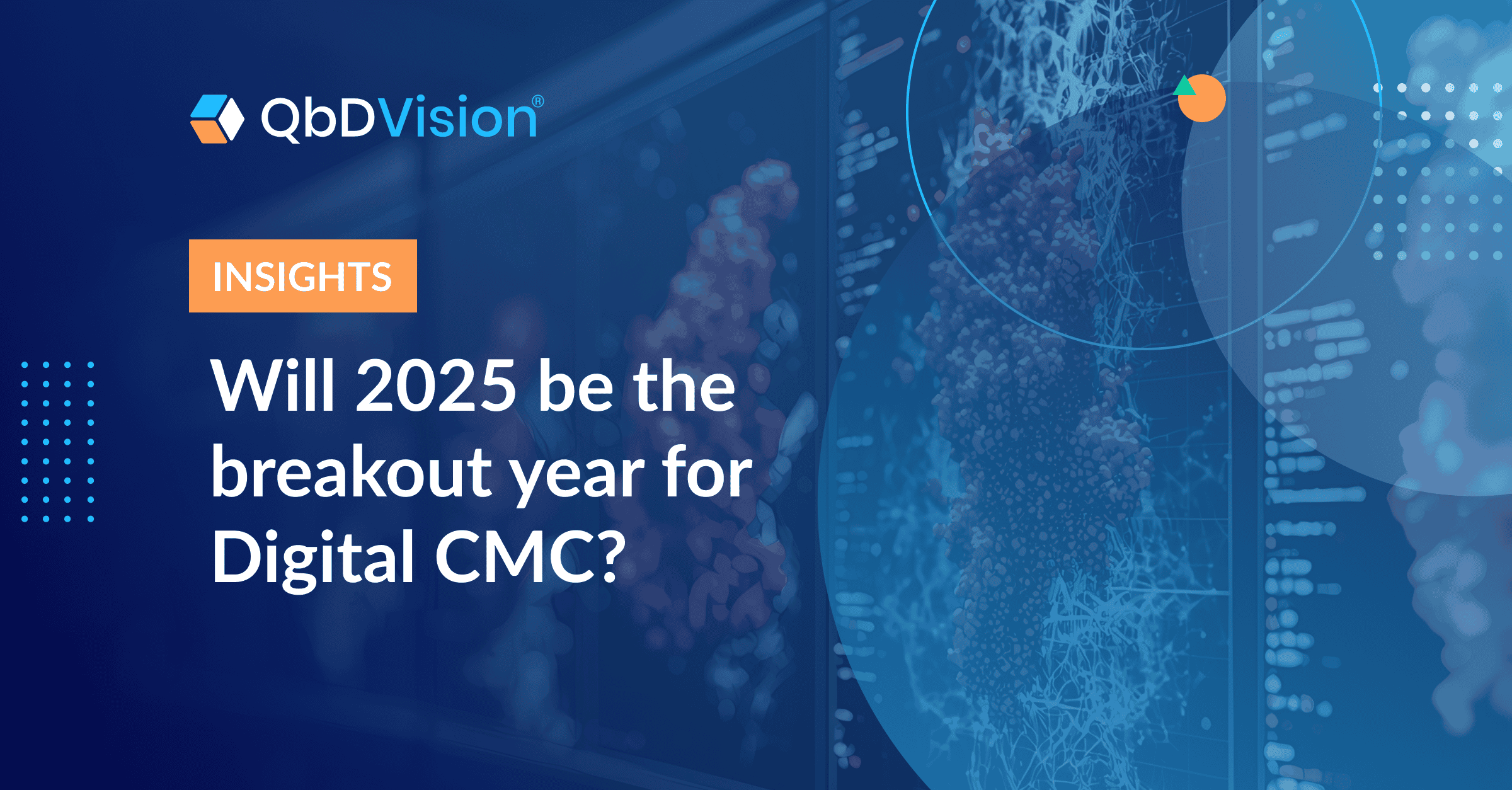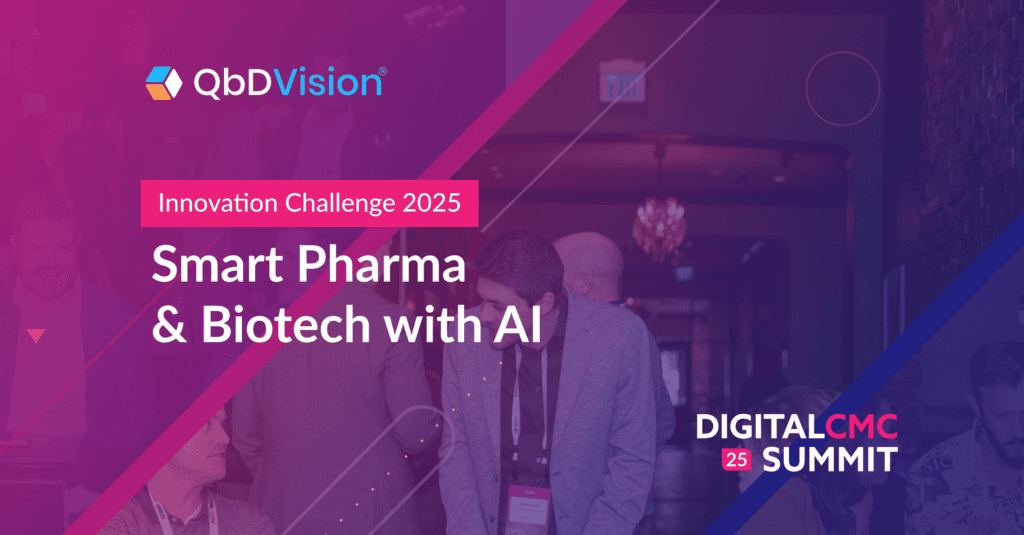So long, 2024. Hello… breakout year for Digital CMC?
Well, we did it: 2024 is officially in the books. And an interesting year it certainly was, full of ups and downs for the entire drug development industry. I’m sure many of our colleagues are happy to put this one in our collective rear-view mirror: after all, it was a tough four quarters for many scrappy startups and global enterprises alike.
But here we are at the dawn of 2025, and I’m happy to say there are many reasons to be hopeful for where the new year will take our industry—especially when it comes to the CMC space. Funding for innovation is starting to rebound. M&A is revving back up. Even the JPM previews are trending positive. But if you’ve had a look at what’s coming to the 2025 Digital CMC Summit, you know some especially exciting things are in store for industry transformation this year.
What exactly? We asked a few of our experts to get their take: Here are the 5 big trends they expect to shape the Digital CMC landscape in 2025.
1. More and more CMC programs will transform at scale
Like all major evolutions of drug development’s operational infrastructure, it’s taken some time for Digital CMC to build traction with all the stakeholders who need to embrace it. But over the past few quarters, the movement has rapidly gained momentum—the kind that not only delivers both measurable ROI and sustainable impact.
Across the industry, top drug developers of every size have both successfully adopted and scaled Digital CMC. Many have already achieved a remarkable level of impact: Accelerated tech transfers, significant operational savings, dramatically streamlined CMC workflows, and more. And as we’ll see at the 2025 Digital CMC Summit, this is just the beginning of a major pivot from achieving discrete ROI to implementing solutions at scale.
In 2025, look for that trend to pick up speed as more organizations recognize the real-world applications and measurable benefits of Digital CMC, and both embrace and deploy it across their organizations. This will be the year proven digital solutions are deployed at scale to reduce development cycle times, achieve cost savings, and enhance overall performance in CMC processes.
In organizations that successfully scale their transformation efforts, we’ll also see a growing number of enterprise-wide digital initiatives—automation, AI, and more—backed by data capabilities unlocked by those same Digital CMC solutions. We’ll hear a lot more about that in Austin this February!
Like all major evolutions of drug development’s operational infrastructure, it’s taken some time for Digital CMC to build traction with all the stakeholders who need to embrace it. But over the past few quarters, the movement has rapidly gained momentum—the kind that not only delivers both measurable ROI and sustainable impact.
2. We’ll see less AI hype and more specialized AI use cases
After nearly two years of technical innovation, investment frenzy, and hyperbolic headlines, the drug development industry has absorbed the initial “wow” of AI’s capabilities—and now wants to see what this technology can really do. For stakeholders exploring the potential of AI, the focus is shifting from excited exploration to practical applications that swiftly deliver value.
Watch for the AI sector to adapt accordingly this year, moving from market-scale ambitions with TAM-focused storylines to smaller, more focused applications where they can deliver tangible impact more quickly. It’s the natural arc of any maturing innovation, and it’s one we’ll definitely see taking shape in drug development this year.
In the world of CMC, watch for more and more real-world AI use cases focused on day-to-day needs, goals, and challenges. We’ll see organizations apply AI in very different ways: not as an experimental novelty or a plug-in tool, but as a core strategic asset in many different CMC workflows. A few of those applications may include:
- Generative AI models optimized to understand technical development data and produce compliance documentation
- ML algorithms designed to optimize production parameters and predict potential quality issues before they occur
- And perhaps even specialized AI agents that can use existing process and product data to independently analyze process challenges, develop control strategies, and execute time-consuming tasks for CMC contributors.
Use cases like these, no doubt, will be the tip of the iceberg. We’ll soon see just how many practical, impact-generating applications are truly possible for CMC—and we fully expect there will be many!
3. A growing number of digital twins will be born
If our predictions are correct, frontline AI applications won’t be the only technological advances that gain major traction this year. As more and more drug development data flows to structured, innovation-enabling formats, we also expect another data-driven innovation to take off: digital twins will likely become a new cornerstone of pharmaceutical manufacturing, enabled by vast and fast-growing volumes of high-quality technical development data.
Way back in 2022, at the inaugural Digital CMC Summit, Dr. Christoph Herwig provided an in-depth look at how his team of researchers were establishing the power and potential of digitally simulated manufacturing processes. Flash forward to 2025, and these sophisticated virtual replicas—once just a fascinating theoretical opportunity—are increasingly a real, development-accelerating asset for life science organizations. Today, drug developers can now simulate entire drug production processes, from QTPP to large-scale manufacturing, using purely in silico simulations based on digital twins—often pairing them with AI to further amplify their capabilities.
This year, we expect drug developers and manufacturers will both accelerate use of virtualized process models to test scenarios, predict potential issues, and optimize production parameters, all with far less expensive, time-consuming physical experimentation. Soon after, watch for that innovation to significantly reduce time-to-market and development costs.
As more and more drug development data flows to structured, innovation-enabling formats, we also expect another data-driven innovation to take off: digital twins will likely become a new cornerstone of pharmaceutical manufacturing, enabled by vast and fast-growing volumes of high-quality technical development data.
4. We’ll see fewer new point solutions and more connected ecosystems
Over the last few years, drug development’s digital landscape has seen a profusion of specialized solutions focused on specific processes, activities, and datasets. But as that landscape matures—and budgets tighten in the face of an unpredictable capital environment—more and more of those solutions are likely to join forces or roll up into larger platforms.
As you’ve no doubt heard by now, “Point solution fatigue is real”—and not just in healthcare generally. The novelty of unique solutions for everything has worn off and been quickly replaced by the frustration of navigating operational, IT, and knowledge management systems that are still every bit as fragmented. Just digitally balkanized now.
This year, watch for industry-wide pressure to address that situation, streamline tech stacks, and winnow them down to the few solutions that do the most for as many stakeholders as possible. And in response, we’ll see many technology innovators joining forces to create the end-to-end solutions that drug sponsors increasingly seek.
We’ve already seen that trend taking shape at the Digital CMC Summit, where numerous experts have explored how the CMC ecosystem is becoming increasingly connected from early process exploration to MES implementation. As efficiency pressures drive further integration in the CMC tech stack, watch for more and more software innovators to come together pre-competitively to determine how they can collectively provide the strongest, most integrated value props.
5. Regulatory pressure will drive the value chain toward the blockchain
Before we trot out this prediction, rest assured: We’re not about to try and sell you on an ICO (though QbDQoin does have a ring to it).
In reality, echoes of DeFi will likely get louder in the drug development industry this year—especially for any groups that share the life cycle continuum with drug manufacturing and distribution.
The seeds of this shift were planted during the pandemic, when the COVID supply chain chaos jolted regulators into turning up the heat on just about everyone involved in distributing therapeutic products. Now, with the Drug Supply Chain Security Act (DSCSA) fully kicking in this year, organizations that support the global flow of drug products will finally need to ensure unit-level traceability.
Many of these stakeholders will need to up their digital game or risk serious non-compliance issues. That acute pressure will likely push some drug developers to look beyond conventional digital toolkits and embrace even more innovative forms of technology: specifically blockchain-enabled systems that promise to transform transparency and traceability in the drug development value chain.
These technologies may help enable immutable, end-to-end tracking of drug development and production processes, from raw material sourcing to final product distribution. Deploying such solutions has the potential to enhance regulatory compliance, reduce the risk of counterfeiting, and provide unprecedented visibility into complex global supply chains.
Of course, we can hear you asking: “That’s all after the tech transfer, how could that possibly impact my CMC program?”
Well, quite simply, data that needs to end up on the chain may ultimately need to start on the chain. As this trend gathers steam, CMC programs may soon feel the pressure to not just structure their data, but do so in a way that’s optimized for a distributed ledger that enables tracking from discovery to distribution.
For process development teams, that may mean further upskilling and data management infrastructure to prepare for on-chain data exchanges—especially if that demand for granular traceability extends upstream in the development lifecycle.
We hope you’re as excited as we are!
This year promises to be a big one for the Digital CMC movement, one technical development innovators have been working toward for a long time now. As we look ahead at 2025, and another global gathering of those innovators, we can feel the momentum swelling and the potential growing by the minute.
Exactly how much of that potential will turn into real, tangible value this year? That remains to be seen, of course—but we can already confidently say that maximizing that impact will take far more than technology. It will take concerted collaboration, strategic change management and thoughtful evolution of transforming business cultures. And we’re happy to say that all of those are a priority for the Digital CMC community!
This year, we hope you’ll join us in advancing all these efforts. There’s a new generation of drug development waiting to be unlocked. Let’s make this the year we make it happen.
GET IN TOUCH
Ready to make this your year of Digital CMC?
Connect with our experts any time to learn how QbDVision can help you level up your program’s knowledge and data management.


























































